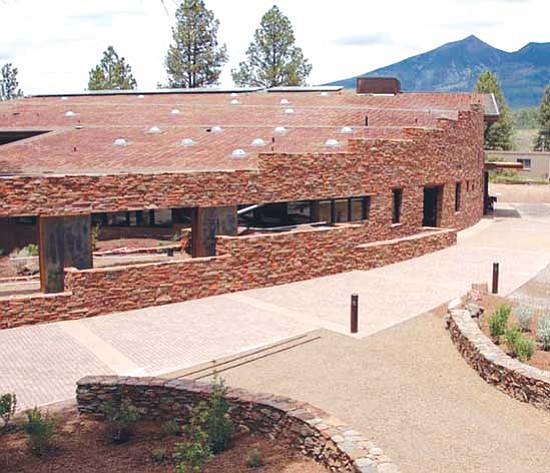MNA celebrates innovation, vision with new Easton Collection Center
<i>Photo by Michele Mountain/MNA</i><br> The Museum of Northern Arizona's Easton Collection Center was dedicated this past Sunday. Named after donors Elizabeth (Betsy) and Harry Easton, the new 17,283 square foot facility will house the MNA's unparalleled and fragile anthropological, biological, and fine art collection. Its unique design honors and blends natural and man-made materials, embracing the worldviews of the region's Native people.
FLAGSTAFF, Ariz. - Caring for our collective past grounds us in the present and guides us towards the future. This core idea was the foundation of the Museum of Northern Arizona's yearlong $5 million Easton Collection Center construction project. At a public dedication ceremony on Sunday, June 21 - the summer solstice - the innovation and vision of the new 17,283 square foot building was celebrated.
Named after donors Elizabeth (Betsy) and Harry Easton of Sedona and Flagstaff, this future home of MNA's unparalleled and fragile anthropological, biological, and fine art collections from the surrounding Colorado Plateau will lead the way in the care and preservation of museum collections nationwide. Its design honors and blends natural and man-made materials and environments, embracing the worldviews of the region's Native people.
"There is a pressing need for this building," said Museum Director Robert Breunig. "Conservators and consultants have been advising MNA for nearly 20 years that we needed to improve our level of care. With this new facility, MNA will finally be able to fulfill its stewardship responsibilities ... It represents the highest aspirations of the museum."
Breunig continued, "The three principles that have guided construction of this new building a commitment to the highest standards of museum collections care (including temperature and humidity, light levels, fire suppression, security systems, and infestation controls), building as green and sustainable as possible (with local building materials and reuse of old materials whenever possible), and embracing Native sensibilities in ways that increase Native access to MNA's collections and illustrate the respect MNA has for the people and cultures of the Colorado Plateau."
It was also important to MNA to include regional Indian tribes in the design process, so they feel comfortable in the building. Representatives of the Navajo Nation, the Hopi Tribe, the Zuni Tribe, and the White Mountain Apache Tribe - all significantly represented in the Museum's collections - formed a Native American Advisory Committee and participated in planning discussions.
"In answer to the committee's requests," said Breunig, "The building has an east-facing entrance to greet the sun every morning; a circular shape to invoke the cycles of life; and connections to the natural world with its living roof, appropriate use of day-lighting, local materials whenever possible, and views of the sacred San Francisco Peaks from both inside the building and out."
Total construction cost for the Easton Collection Center is estimated at $7 million, including building construction, architectural and engineering fees, living roof design and construction, and cabinetry.
Funding for steel collections storage cabinetry, equipment, and move coordination has come from four major grants totaling $1,047,235: a 2009 Institute for Museum and Library Services (IMLS) grant of $114,924 for botany and entomology cabinetry, a 2008 IMLS grant of $107,311 for textile and basket cabinetry, a 2007 National Endowment for the Humanities (NEH) grant of $575,000 for a compactor track system, anthropology cabinetry, and move coordination, and a 2006 Save America's Treasures grant of $250,000 for archaeology cabinetry.
The Collection Center sits at the base of the San Francisco Peaks and is built across Highway 180 from the museum's exhibit building, in the heart of the museum's historic Harold S. Colton Research Center. MNA and its architects brought a comprehensive philosophy of environmental sustainability to the design of the building, with maximum energy efficiency and minimum use of fossil fuels.
The building has a living roof of native grasses and wildflowers to create greater insulation, deter runoff and reduce erosion, and create additional habitat for birds and insects. The use of efficient water fixtures, rainwater runoff harvesting, and native plants saves water.
Its green building features embody MNA's commitment to environmental sustainability and make it eligible to be registered through the Green Building Council's prestigious Leadership in Energy and Environmental Design® (LEED) certification program. Buildings are rated Certified, Silver, Gold, or Platinum based on a number of rating categories such as site selection, water and energy conservation, use and recycling of materials, indoor air quality, education, design innovation, and landscaping. Although the US Green Building Council determines the final rating only after buildings are actually completed, MNA anticipates that the Easton Collection Center will receive the highest LEED rating of Platinum.
The building's orientation, thermal mass, highly insulated roof, UV filtered skylights, insulated windows, photovoltaic solar panels, and energy saving fixtures reduce the production of greenhouse gases. The building uses materials recycled from old buildings that were replaced. And where possible, the design team selected regionally manufactured materials to reduce transportation costs.
In parts of the building, the cellulose wall insulation is made from recycled newspapers, and paints and other materials are low in volatile organic compounds to improve air quality.
SUBMIT FEEDBACK
Click Below to:




